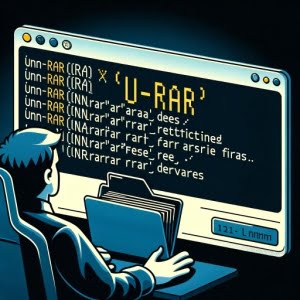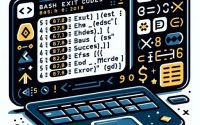Unrar Command Guide | Extracting RAR Files in Linux

Ever found yourself stuck with a RAR file in Linux, unsure of how to unlock its contents? Many users find themselves in a similar situation, but the ‘unrar’ tool can help you out. Think of the ‘unrar’ command in Linux as a key that can unlock the contents of a RAR file, providing you access to the data stored within. It’s a powerful utility that’s often overlooked, but once mastered, it can be a game-changer in handling RAR files in Linux.
This guide will walk you through the steps to use the ‘unrar’ command effectively in Linux. We’ll explore everything from the basic usage of the command, to more advanced features, and even discuss common issues and their solutions.
So, let’s dive in and start mastering the ‘unrar’ command in Linux!
TL;DR: How Do I Use the ‘unrar’ Command in Linux?
To extract a RAR file in Linux, you use the
'unrar'command followed by ‘x’ and the filename. The template for the syntax would be,unrar [x] file.txt. This command unlocks the contents of the RAR file, making them accessible for use, but there are other options available to use as well.
Here’s a simple example:
unrar x file.rar
# Output:
# Extracting file.rar
# All OK
In this example, we use the ‘unrar’ command followed by ‘x’ (which stands for extract) and the name of the RAR file we want to extract. The command extracts the contents of ‘file.rar’ into the current directory.
This is a basic way to use the ‘unrar’ command in Linux, but there’s much more to learn about extracting RAR files and handling potential issues. Continue reading for more detailed information and advanced usage scenarios.
Table of Contents
- The Basics of the ‘unrar’ Command
- Advanced ‘unrar’ Command Usage
- Exploring Alternatives: Other Ways to Extract RAR Files in Linux
- Troubleshooting Common ‘unrar’ Command Issues
- Understanding RAR Files and the ‘unrar’ Command
- Broadening Horizons: The Relevance of ‘unrar’ Command
- Wrapping Up: Unlocking Linux Files with ‘unrar’
The Basics of the ‘unrar’ Command
The ‘unrar’ command in Linux is a powerful utility that allows you to extract RAR files. It’s a tool that’s easy to use, yet incredibly effective. Let’s dive into the basics of how to use it.
The basic syntax of the ‘unrar’ command is as follows:
unrar x [filename]
In this command, ‘x’ is an option that tells the ‘unrar’ command to extract the files with full paths. The [filename] should be replaced with the name of the RAR file you wish to extract.
For instance, if you have a RAR file named ‘archive.rar’, you would use the following command:
unrar x archive.rar
# Output:
# Extracting archive.rar
# All OK
This command extracts all the files from ‘archive.rar’ into the current directory.
One of the main advantages of the ‘unrar’ command is its simplicity. With just a few keystrokes, you can extract an entire RAR file. However, one potential pitfall is that if a file with the same name already exists in the directory, the ‘unrar’ command will overwrite it without prompting. So, always make sure to check the contents of the directory before extracting a RAR file.
Advanced ‘unrar’ Command Usage
As you get more comfortable with the ‘unrar’ command, you’ll discover it’s capable of more than just basic file extraction. It’s loaded with options that can help you manage your files more effectively. Let’s explore some of these advanced features.
Before we dive deeper, let’s familiarize ourselves with some of the command-line arguments or flags that can modify the behavior of the ‘unrar’ command. Here’s a table with some of the most commonly used ‘unrar’ arguments.
| Argument | Description | Example |
|---|---|---|
x | Extract files with full paths. | unrar x file.rar |
e | Extract files without archived paths. | unrar e file.rar |
p | Print file to stdout. | unrar p file.rar |
l | List archive content. | unrar l file.rar |
t | Test archive files. | unrar t file.rar |
v | Verbosely list archive. | unrar v file.rar |
c- | Disable comments show. | unrar x -c- file.rar |
cfg- | Disable read configuration. | unrar x -cfg- file.rar |
idq | Disable done messages. | unrar x -idq file.rar |
inul | Disable all messages. | unrar x -inul file.rar |
kb | Keep broken extracted files. | unrar x -kb file.rar |
o+ | Overwrite existing files always. | unrar x -o+ file.rar |
o- | Never overwrite existing files. | unrar x -o- file.rar |
p[password] | Set password. | unrar x -pMySecret file.rar |
Now that we’re familiar with these arguments, let’s explore some scenarios where they can be used.
Extracting Files to a Specific Directory
By default, ‘unrar’ extracts files into the current directory. But what if you want to extract them to a specific directory? You can do this by appending the path of the directory at the end of the command.
unrar x archive.rar /home/user/documents/
# Output:
# Extracting archive.rar to /home/user/documents/
# All OK
In this example, all files from ‘archive.rar’ are extracted to the ‘/home/user/documents/’ directory.
Handling Password-Protected RAR Files
Sometimes, RAR files are password-protected. You can extract these files using the ‘p’ argument followed by the password.
unrar x -pMySecret archive.rar
# Output:
# Extracting archive.rar
# All OK
In this example, ‘MySecret’ is the password for ‘archive.rar’. The command extracts the contents of the file as usual, after unlocking it with the password.
Remember, mastering these advanced ‘unrar’ command features can help you handle RAR files more efficiently in Linux. So, keep exploring and experimenting!
Exploring Alternatives: Other Ways to Extract RAR Files in Linux
While the ‘unrar’ command is a powerful tool for handling RAR files in Linux, it’s not the only one. There are other utilities like ‘7zip’ and ‘tar’ that can also get the job done. Let’s explore these alternatives and see how they stack up against ‘unrar’.
Extracting RAR Files Using 7zip
7zip is a versatile file archiver with high compression ratio. It can handle various archive formats including RAR. Here’s how to use it to extract a RAR file:
7z x archive.rar
# Output:
# Extracting archive.rar
# Everything is Ok
In this example, ‘7z x archive.rar’ extracts the contents of ‘archive.rar’. The ‘x’ argument tells 7zip to preserve directory structures.
One of the benefits of using 7zip is its ability to work with a multitude of archive formats. However, it might not be pre-installed on all Linux distributions, so you might need to install it first.
Unpacking RAR Files Using tar
The ‘tar’ command is another utility for file archiving. While it doesn’t support RAR files directly, we can use it in conjunction with other tools like ‘unrar’ to extract RAR files. Here’s how:
unrar e -idq archive.rar && tar xvf archive.tar
# Output:
# 'archive.rar' extracted
# 'archive.tar' unpacked
In this example, we first use ‘unrar e -idq archive.rar’ to extract the RAR file. The ‘e’ argument tells ‘unrar’ to extract files without archived paths, and ‘-idq’ disables done messages. Then we use ‘tar xvf archive.tar’ to unpack the tar file.
The advantage of this approach is that ‘tar’ is pre-installed on almost all Linux distributions. However, it requires an extra step and can be a bit cumbersome if you’re dealing with RAR files frequently.
In conclusion, while ‘unrar’ is a powerful tool for handling RAR files in Linux, there are several alternatives like ‘7zip’ and ‘tar’ that offer different benefits. The choice between these tools depends on your specific needs and preferences.
Troubleshooting Common ‘unrar’ Command Issues
Like any tool, the ‘unrar’ command in Linux can sometimes present challenges. Let’s explore some common issues you might encounter and how to solve them.
‘Command not found’ Error
One of the most common errors you might encounter is the ‘Command not found’ error. This typically happens when the ‘unrar’ package is not installed on your Linux distribution.
unrar x archive.rar
# Output:
# bash: unrar: command not found
If you encounter this error, you can install ‘unrar’ using the package manager of your Linux distribution. For instance, on Debian-based systems like Ubuntu, you can use the following command:
sudo apt-get install unrar
# Output:
# Reading package lists... Done
# Building dependency tree
# Reading state information... Done
# The following NEW packages will be installed: unrar
# 0 upgraded, 1 newly installed, 0 to remove and 0 not upgraded.
After running this command, you should be able to use the ‘unrar’ command without any issues.
‘Archive is corrupt’ Error
Another common issue is the ‘Archive is corrupt’ error. This usually happens when the RAR file is damaged or incomplete.
unrar x archive.rar
# Output:
# Extracting archive.rar
# The archive is corrupt
If you encounter this error, the first thing you should do is verify the integrity of the RAR file. If you have access to the original source, try downloading the file again. If that’s not an option, you can use the ‘r’ option in ‘unrar’ to try and repair the file.
unrar r archive.rar
# Output:
# Repairing archive.rar
# Building rebuilt.rar
In this example, the ‘r’ option attempts to repair ‘archive.rar’ and creates a new file named ‘rebuilt.rar’.
Remember, encountering issues is a part of working with any command in Linux. The key is to understand the problem and find the right solution. Happy troubleshooting!
Understanding RAR Files and the ‘unrar’ Command
Before we delve deeper into using the ‘unrar’ command, it’s crucial to understand what RAR files are. RAR (Roshal Archive) is a proprietary archive file format that supports data compression, error recovery, and file spanning. It’s popular for its efficiency in compressing large files and ease of sharing.
The ‘unrar’ command is a utility in Linux used to extract files from this RAR format. It’s not a standard tool in many Linux distributions and might need to be installed manually.
Installing ‘unrar’ in Different Linux Distributions
The installation process for ‘unrar’ varies depending on your Linux distribution. Here are installation commands for some popular distributions:
Debian/Ubuntu
sudo apt-get install unrar
# Output:
# Reading package lists... Done
# Building dependency tree
# Reading state information... Done
# The following NEW packages will be installed: unrar
# 0 upgraded, 1 newly installed, 0 to remove and 0 not upgraded.
Fedora
sudo dnf install unrar
# Output:
# Last metadata expiration check: 0:00:01 ago on Mon 24 Jan 2022 07:23:34 PM EST.
# Dependencies resolved.
# ================================================================================
# Package Architecture Version Repository Size
# ================================================================================
# Installing:
# unrar x86_64 5.6.8-1.fc32 rpmfusion-nonfree-updates 98 k
# Transaction Summary
# ================================================================================
# Install 1 Package
Arch Linux
sudo pacman -S unrar
# Output:
# resolving dependencies...
# looking for conflicting packages...
# Packages (1) unrar-1:5.9.4-1
# Total Download Size: 0.11 MiB
# Total Installed Size: 0.28 MiB
# :: Proceed with installation? [Y/n]
Once you’ve installed ‘unrar’, you can start using it to extract RAR files in your Linux system. Remember, understanding the fundamentals of RAR files and the ‘unrar’ command is key to using it effectively.
Broadening Horizons: The Relevance of ‘unrar’ Command
The ‘unrar’ command in Linux is not just about extracting RAR files. Its utility goes beyond that, making it a versatile tool in file handling and scripting in Linux.
‘unrar’ in File Handling
In the realm of file handling, ‘unrar’ is a powerful tool. It allows you to extract files from RAR archives, which is particularly useful when dealing with large files or collections of files. The ability to handle RAR files can be a game-changer, especially when working with data sets, application resources, or any situation where files are commonly compressed in RAR format.
‘unrar’ in Scripting
The ‘unrar’ command can also be incorporated into scripts to automate the extraction process. For instance, you might have a script that downloads a series of RAR files from a server, and then uses ‘unrar’ to extract them. This can save you a lot of time and effort in the long run.
#!/bin/bash
# Script to download and extract RAR files
for file in $(cat list.txt)
do
wget $file
unrar x $(basename $file)
done
# Output:
# 'file1.rar' downloaded and extracted
# 'file2.rar' downloaded and extracted
In this script, we’re using ‘wget’ to download a series of RAR files listed in ‘list.txt’, and then ‘unrar’ to extract them. This is just a simple example, but it demonstrates how ‘unrar’ can be used in scripting.
Exploring Related Concepts
If you’ve mastered the ‘unrar’ command and are looking for more to learn, consider exploring related concepts like file compression and file archiving. These topics delve into the reasons why we use tools like ‘unrar’ in the first place, and can provide a deeper understanding of file management in Linux.
Further Resources for Mastering ‘unrar’ and Related Concepts
- GNU ‘tar’ Manual: A comprehensive guide to the ‘tar’ command, a powerful tool for file archiving in Linux.
7-Zip Documentation: Detailed documentation for 7-Zip, another utility for handling compressed files.
The Linux Command Line by William Shotts: A free book that provides a broad introduction to the command line, including file management commands.
Remember, the journey of mastering the Linux command line is a marathon, not a sprint. Keep exploring, keep learning, and most importantly, keep practicing!
Wrapping Up: Unlocking Linux Files with ‘unrar’
In this comprehensive guide, we’ve delved deep into the usage of the ‘unrar’ command in Linux. We’ve explored how this powerful tool unlocks the contents of RAR files, making them accessible for use in your Linux system.
We started with the basics, learning how to use the ‘unrar’ command to extract RAR files. We then delved into more advanced usage scenarios, such as extracting files to specific directories and handling password-protected RAR files. Along the way, we tackled common issues you might face when using ‘unrar’, such as the ‘command not found’ error or ‘archive is corrupt’ error, and provided solutions to help you overcome these challenges.
We also explored alternative approaches to handling RAR files in Linux, introducing you to other methods like ‘7zip’ and ‘tar’. Here’s a quick comparison of these methods:
| Method | Pros | Cons |
|---|---|---|
| ‘unrar’ | Powerful, supports many options | May require troubleshooting for some files |
| ‘7zip’ | Versatile, supports various archive formats | Not pre-installed on all Linux distributions |
| ‘tar’ | Pre-installed on almost all Linux distributions | Requires an extra step to handle RAR files |
Whether you’re just starting out with the ‘unrar’ command or you’re looking to level up your file handling skills in Linux, we hope this guide has given you a deeper understanding of ‘unrar’ and its capabilities.
With its balance of power and versatility, the ‘unrar’ command is an indispensable tool for handling RAR files in Linux. Keep exploring, keep learning, and happy ‘unraring’!


